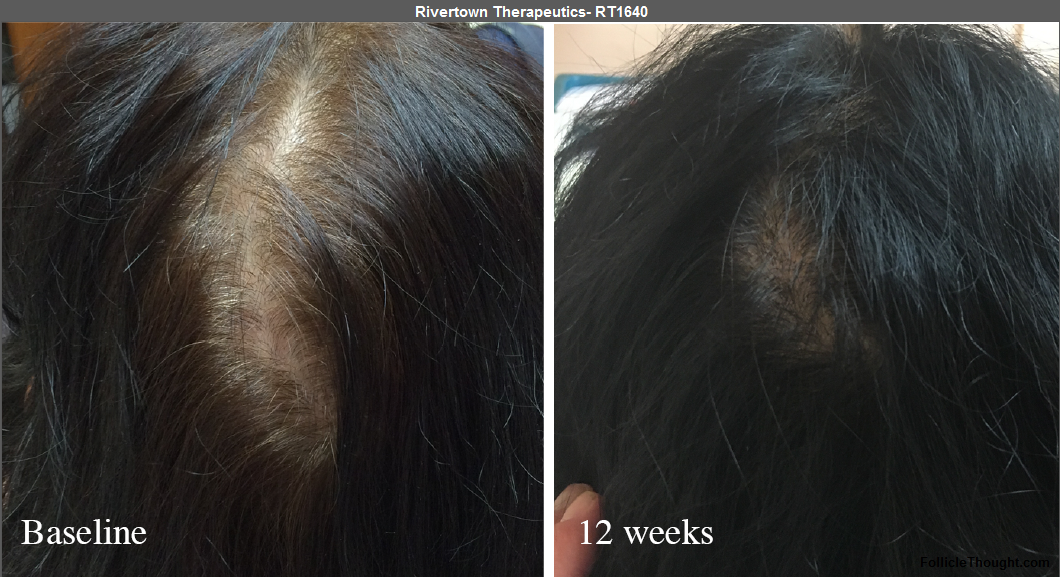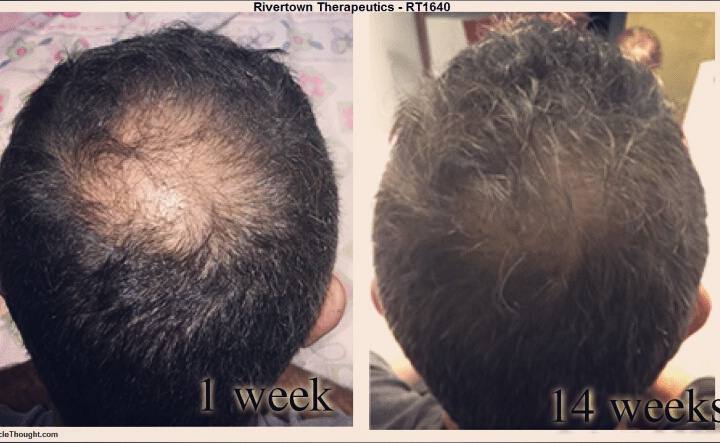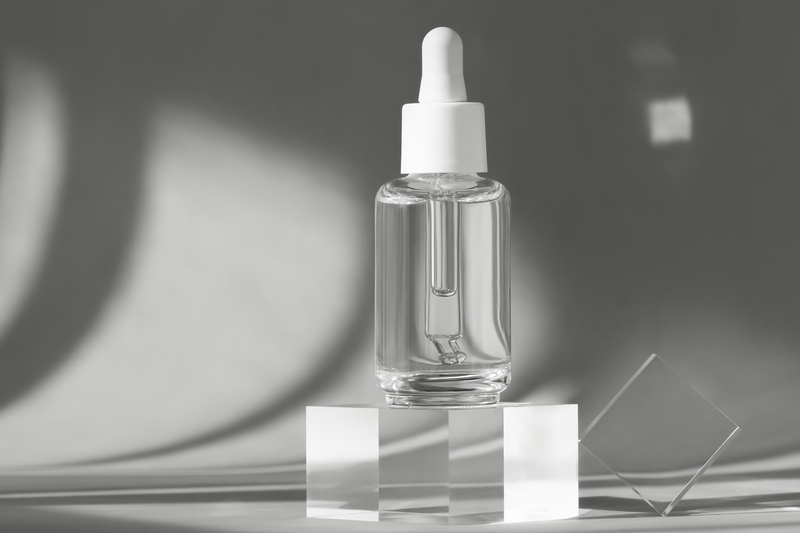The Biotech Hair Loss Cure: Does It Work?
We’ve seen a number of very interesting attempts to cure baldness from the tech folks in Silicon Valley.
If modern medicine is still struggling to deal with the emergent problem of hair loss, then maybe some keen outsiders might be able to create a solution.
Some of these novel solutions come from a New Yorker article we dug up titled “Is the Age-Old Quest for a Baldness Cure Reaching Its End?” and we want to give them some attention
But we’re also going to add in some other products we’ve found that tackle baldness in some very interesting ways.
RT1640: A Tri-Drug Therapy For Reversing Grey Hair?
The New Yorker article starts by profiling Dr. David Weinstein, a Manhattan-based neuroscientist specializing in nerve regeneration and spinal-cord injuries.
After having some success in experimentally using a drug compound called RT1640 on his head, he founded RiverTown Therapeutics to continue development of the drug.
One scientific paper we were able to dig up summarizes what this drug does and how it works:
“RT1640 consists of three drugs, cyclosporine A (CsA), minoxidil, and RT175 (an immunophilin ligand).
RT175 is a derivative of the immunosuppressant FK506 (also known clinically as Tacrolimus). Historically, FK506 was shown to have both immunomodulatory and regenerative properties that function through independent mechanisms. The non-immunosuppressive immunophilins ligands, like RT175, were developed to capitalize on the regenerative aspects of FK506 while avoiding the negative side effects associated with the immune role of this drug… ). FK506 can enhance hair regrowth in rodents, but its efficacy in human alopecia is limited”
“CsA is an immunosuppressive calcineurin inhibitor which modulates hair growth by inducing and prolonging anagen, enhancing hair follicle stem cell activity, and blocking the ability of the dermal papilla cells to initiate catagen”
“Minoxidil is commercially available, and while only moderately effective in treating hair loss in humans, does so by promoting the telogen-to-anagen transition, increasing the percentage of larger hair follicles, and reducing hair shedding. Minoxidil mediates these effects through its multifaceted influence on cells of the dermal papilla, subcutaneous adipose tissue, and the perifollicular vasculature”
In a 2019 interview Dr. Weinstein did with Follicle Thought, he claimed 100% of patients “have had satisfactory growth and a significant percentage have had complete hair regeneration” and was in the middle of raising funds for a Phase Ib/IIa study.
Here are images he claims were the results of using RT1640 for four months in a 42-year-old man and a 60-year-old woman:
However, there are some concerns with this product.
One hair loss review website notes the toxic safety profile of Cyclosporine A, although Dr. Weinstein has claimed it is safe to use in a topical formulation. Another concern involves the ingredient RT175 and its lack of an established profile (Dr. Weinstein claims RT175 has been tested in 175 patients without any safety concerns)
Finally, although we were unable to corroborate this with an official source, there is a rumor that RiverTown Therapeutics “called it quits” in December 2020.
But as we’ve discussed before, Minoxidil is NOT an effective solution to hair loss.
Even the New Yorker acknowldges this:
“…the working theory is that minoxidil protects the dermal papilla from DHT. , or finasteride, was originally developed as a treatment for enlarged prostates. It inhibits the creation of DHT.
Both products have drawbacks. In order to be effective, minoxidil must be applied daily. Because of the hormonal imbalance that finasteride causes, women can take it only if they are postmenopausal. If you stop taking either drug, you will quickly lose the hair you would have lost in the duration of your usage.”
Close but no cigar!
And even if you hate your grey hair, some women find it VERY attractive! 😉
“Subscription” Hair Loss Products – More Convenient Access, But A Problem Still Unsolved
Despite the obvious failings of drugs such as Finasteride to treat hair loss, very few people are inherently aware of the benefits and risks behind them.
Which is why many startups have exploded in growth by merely making these same products available for a monthly fee via delivery to your home.
From the New Yorker Article:
“Last fall, the San Francisco startup Hims began a small publicity blitz. Its ads were all over in-boxes and social-media feeds and TV screens; they were even out in real life, on paper placards. Above a picture of a handsome young man with long, luscious dark hair, there was a bold claim: “Thanks to science, baldness is now optional.” Hims, which also sells shampoos and erectile-dysfunction medication, has a minimalist aesthetic, designed by Partners & Spade. (The agency has done work for famed disruptors such as Warby Parker and Casper.)
It also has an in-house journal called Savoir Faire. And, within all that attractive packaging and identity branding, the company was very casually offering the holy grail. My latent obsession led me to ask some questions of the ad campaign.
It turns out that Hims’s baldness pills are just finasteride, and their topical solution minoxidil. Thanks to expired patents on those products, Hims is able to sell them cheap. And yet ultimately they’re providing the same old solution. Another false prophet.”
Yet so long as people remain mesmerized by Main Street marketing, companies like these — despite being well-intentioned — will continue to thrive.
Cell-Based Therapies: Promising, But Needs More Research
Speaking of Follicle Thought, its owner (pseudononymously known as “Joseph) mentioned platelet-rich plasma and stem cell therapies as the new “hot” thing in hair loss:
“He ticked off “platelet-rich plasma” and “injectable cell therapies” and other high-level technologies that are being developed by companies from New York to San Diego, Tokyo, and Stockholm. He won’t make bets on who’s going to win the arms race.
But, he says, ‘if you were the first, that’d be fun for the trillion dollars that you’d make. Over the next few years? It’s prime time.'”
The New Yorker article then goes into detail to describe several companies who are approaching hair growth through this angle:
“The San Diego company Histogen has been around since 2007, making it a veteran in this inchoate field. Histogen is working toward “an injectable for hair growth,” its founder, Dr. Gail Naughton, told me. What Histogen wants to inject in you are extracts from “neonatal cells grown under simulated embryonic conditions.” Histogen is convinced that these cells stimulate “growth factors” that signal hair formation. That’s option No. 1: first, a cell solution is whipped into a hair-growing frenzy, in a lab; then it’s punched into your head.”
“In Vancouver, a Canadian company called RepliCel focusses on the hair follicle’s “dermal-sheath cup cells,” its C.E.O., Lee Buckler, explained. Buckler believes that DHT attacks these cup cells “like a parasite.” Like Histogen, RepliCel’s consumer product would be an injectable. The company would generate new versions of your cup cells, which would be implanted into your “affected area”—the places where your hair has fallen out. Boom: new hairs. (Theoretically.)”
“In Sweden, a company called Follicum is now doing Phase IIA clinical studies and planning to communicate results by the end of the year. The end product will be a cream or a lotion, one that could be applied as few as three times a week. In the first trial, Follicum claims, more than seventy-five per cent of patients experienced hair growth”
Some of the long-standing issues with these therapies include a very high cost per treatment, lack of accessibility, unfavorable side effects, and a lack of a standardized protocol.
But hey — we’re not ones to hate on progress and it’s fair to say a lot of people are excited to see what new developments happen in this niche.
Auxano Grow: Tapping Into The Power Of Therapeutic Peptides
One product that’s received an extraordinary amount of media attention is Auxano Grow V2, created by Aseir custom co-founders Jay Campbell and Nick Andrews.
Auxano Grow’s two main active ingredients are copper peptide GHK-Cu and biomolecule C60, both of which are claimed to work synergistically in the synthesis of new hair follicles and the accelerated growth of said follicles.
Their science page provides more detail:
“When Serum A (Copper peptide GHK-Cu) is massaged into the scalp, it enhances angiogenesis (increased blood flow) and the promotion of new blood vessel growth topically in the dermis of the scalp by suppressing topical inflammation through improved mitochondrial function. (In other words, each hair follicle will receive more blood supply and oxygen via the capillary it is connected to).”
“GHK-Cu also has the ability to prevent hair follicles from shrinking in size, even helping them become exceptionally large: In short, GHK-Cu decreases hair loss and thickens the areas where your scalp is thinning while strengthening your current follicles making them fuller and thicker.
Serum B (Carbon 60) is a unique molecular arrangement of 60 carbon atoms into a close fullerene structure known as a ‘buckyball’ or a buckminsterfullerene). It is a profound antioxidant and immune booster and when massaged into the scalp has been shown to increase the number of hair follicles in the dermis while also acting as a powerful super antioxidant that fights oxidative stress in the follicle roots.
Neither compound interferes with DHT production or the production of any androgen which makes it entirely free of side effects from biological system (hormonal) manipulation often found in competitor products.”
So far, despite skipping clinical trials and validating their product the “official” way, many customers have shared photos and claimed the product has worked for them when nothing else does.
If they can fix the problem of hair growth without having to continually use their product for life (as they claim), maybe there will finally be an end to this centuries-old problem.
Should You Attempt to Cure Hair Loss Once And For All?
We’ve previously talked about the numerous ways in which hair loss can sabotage your life — your professional life, your personal life, and your love life.
Even the New Yorker acknowledges this lifelong pursuit by man and science to help people grow and maintain a full head of hair:
“Hair growth is a giant industry, with estimated annual sales of $3.6 billion. And every one of those dollars goes to products that do not provide actual hair regeneration”
“…in 2013—German researchers published a study indicating that men experienced hair loss as an “enormous emotional burden” that could lead to an “impaired quality of life” and “psychological disorders.” Inversely, one study has shown that people perceive men with bountiful hair as likely having big penises.”
“People are also much, much more likely to vote for political candidates with hair. Only five elected American Presidents—John Adams, John Quincy Adams, Martin Van Buren, James Garfield, and Dwight Eisenhower—were bald or balding. Considering that eighty-five per cent of men older than fifty suffer hair loss, that’s an astonishing record.”
“It is no surprise that Donald Trump is obsessed with hair loss. “Never let yourself go bald,” he once told a Trump Organization executive. “The worst thing a man can do is go bald.” During their brief dalliance, Stormy Daniels confronted him about his hair. “I was like, ‘Dude, what’s up with that?’ ” she said, to In Touch, in 2011. Trump laughed. Then he told her that he worried that “if he cut his hair or changed it, that he would lose his power and his wealth.” Recently, Trump’s physician admitted that the President takes the anti-baldness medicine .”
But while we continue to wait for the magic elixir, we can’t help but recommend Vantis Follicle Replication as the world’s best aesthetic solution for hair loss.
Like Auxano Grow V2, treatment STOPS when you get your desired results. Plus, it’s non-invasive… without any side effects whatsoever.
And unlike other hair loss solutions, Vantis Institute in Orange County, California has worldwide patents pending. Top celebrities, CEO’s, entrepreneurs and sports stars travel from all over the world to get Vantis Follicle Replication and leave with thicker, fuller looking hair.
It’s never too late to use our proprietary service, and you will ALWAYS look like you have a full head of hair (even if you choose to shave it all off).
Come in, get fixed, and live your life. You can go to the gym without a hat, go to the pool and beach without anyone seeing thinning or bald spots, and never have to fear social situations or photographers again.
So when you’re ready to stop listening to people who tell you that a bald scalp is the only possible future that awaits you, there are 3 easy things you can do right now…
- Visit our hair loss clinic in Newport Beach, California and receive a Free Consultation with a Vantis hair loss expert.
- Call or text (949) 577-6531 to talk to a VFR expert practitioner now
- Receive a virtual consultation via Zoom, Facetime, WhatsApp, GoogleMeet or Skype to answer all of your questions and develop a personalized treatment plan to achieve your hair growth desired results. Schedule your FREE consultation here






